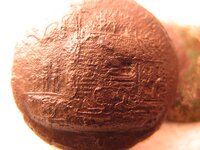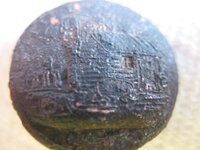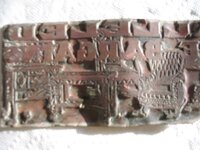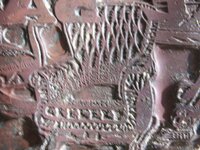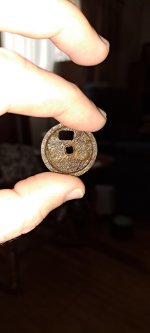Hunterhound
Jr. Member
I have several questions about various relic and coin cleaning methods I've researched in the last couple days. I wanted to post them here to get everyone's thoughts on them. I apologize in advance for two things. 1. Several of these methods have likely been covered in other posts. I hope my questions will be direct enough that you guys will not feel you're repeating too much previous guidance. 2. For the length of this post.
Electrolysis for iron objects and coins?
Cleaning copper
Cleaning silver and gold?
The most prevalent and promising method for cleaning silver seems to be utilizing some type of dish lined with a sheet of aluminum foil. The people laid their silver on the aluminum foil and covered it with baking soda. They then pour in boiling or hot water and let the silver sit for a little while. Some added additional baking soda periodically but none of them indicated how often this should be done. Some also used a soft bristle brush to move the silver around and gently scrub it when it came out of the solution. They made the disclaimer the silver must be thoroughly washed to remove trapped baking soda and get the solution off the silver to prevent damage to the silver over time. Another person made a weak hydrochloric acid solution with white vinegar and baking soda to clean his silver.
Questions:
General Questions:
Electrolysis for iron objects and coins?
After watching several youTube videos on electrolysis, it seems the general apparatus involves a non-conductive container (glass, plastic), with an electrical current (old plug with split wire tied to alligator clips, car battery charger), with the positive lead hooked to a piece of junk steel (old railroad object, car rotor) out of the water and the negative lead hooked to the object in the water. Solution is normal tap water covering the object with approximately 1 tablespoon of washing soda per gallon of water. Some recommended baking soda but one guy used washing soda and it seemed to produce some good results.
Questions:
Questions:
- Is this the recommended apparatus by you guys?
- Do I have to use a battery charger or will any plug that can carry DC current be sufficient as long as I can find some clips to old to the object and steel?
- Can this be used to clean copper and bronze coins? I saw a guy on youtube use this on an old coin but he said you'd have to watch it pretty close otherwise the copper will begin to be eaten by the process.
- If this process can be used on coins, is there something you can use on the alligator clip that connects to the coin to keep the clip from scratching the coin?
Cleaning copper
Gusy seemed to use a variety of methods for cleaning copper/bronze on youTube.
Questions:
- I saw a guy use lemon juice and water but said this could seriously damage the coin if you don't know exactly how long to leave it in the solution.
- One guy used a solution of vinegar and salt and said this should remove all oxidation and whatnot from the coin. Using this method, the coin turned brighter as soon as he put it in the solution which makes me think this is likely a harsh cleaning process. It seemed to produce good results but it makes me nervous.
- Another guy used pool shock (27% Hydrogen Peroxide), heated it to boiling (about 25 secs) in microwave and then added the coin. After about 15 minutes, the coin seemed to be pretty clean. He then used baking soda on the coin after getting it wet and rubbed it with his fingers and/or a soft bristle brush to finish the cleaning process. He also cleaned some wheaties in a rock tumbler with small pea gravel, water just covering the rocks, and a few drops of dish soap.
- Lastly, one guy heated up olive oil and dropped in a copper coin. After an undetermined amount of time, he pulled the coin out, dried it, and then scrubbed it lightly with baking soda and a little water.
Questions:
- Which method will produce the best results without damaging the coins? Another guy just got the coppers wet and scrubbed them gently with a toothpick and q-tips to improve the look, then added parafin or candle wax to polish up the coin and Prevent it from future corrosion?
- If these methods are all useful, which method will produce the least amount of damage to the coin's finish?
- Is there a year where the metal composition of the coins changed which would make any of these procedures more damaging or less effective?
Cleaning silver and gold?
The most prevalent and promising method for cleaning silver seems to be utilizing some type of dish lined with a sheet of aluminum foil. The people laid their silver on the aluminum foil and covered it with baking soda. They then pour in boiling or hot water and let the silver sit for a little while. Some added additional baking soda periodically but none of them indicated how often this should be done. Some also used a soft bristle brush to move the silver around and gently scrub it when it came out of the solution. They made the disclaimer the silver must be thoroughly washed to remove trapped baking soda and get the solution off the silver to prevent damage to the silver over time. Another person made a weak hydrochloric acid solution with white vinegar and baking soda to clean his silver.
Questions:
- Do any of you use either technique? Which is safer and will either cause damage to the coins/jewelry?
- Can either process be used to clean gold as well?
- Can you and should you coat the silver with parafin or candle wax after cleaning to keep the silver from tarnishing in your collection?
- Can either method be used to clean coins that are only partially silver such as war nickles (35% silver)?
General Questions:
- What should wax not be used on?
- Is Parafin wax the best wax to use for preservation?
- How do you guys heat your wax? One guy used an outdoor propane grill considering the parafin wax should not be heated above 250* to which could cause the wax to bubble over and catch fire if encountering a flame.


